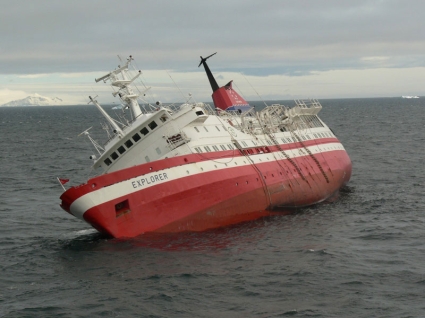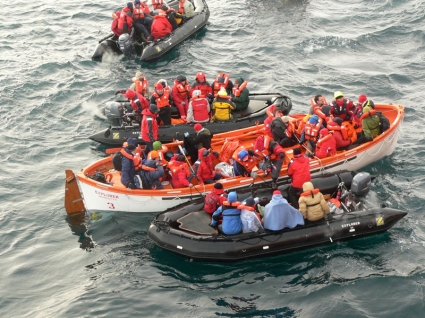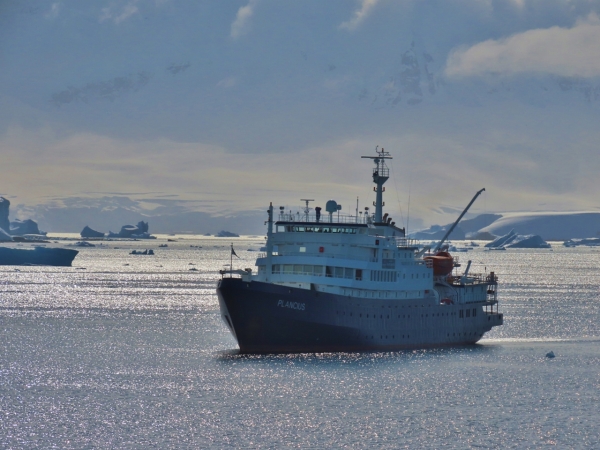In Choose Your Cruise Operator Carefully, we discussed the risks inherent in an Antarctic cruise, and described the three deaths that had occurred in the course of two weeks near the start of the 2022-2023 cruise season. It turns out there was actually four deaths in that period. The situation has become serious enough that both the US Coast Guard and the National Transport Safety Board (NTSB) have sent teams to Ushuaia, Argentina to participate in the accident investigations.
The little-publicized fourth fatality occurred aboard the expedition ship Plancius operated by Oceanwide Expeditions (pictured at the top of this post in Paradise Bay, Antarctica). According to a Washington Post report, the person died after an accidental fall that was not part of an on-board activity or landing.
The Plancius was one of several vessels that have suffered engine problems during Antarctic cruises over the past decade. In 2012, while en-route from Ushuaia to South Georgia the ship experienced a propulsion failure that reduced the vessel’s speed to 4-5 knots in calm conditions. The ship reached South Georgia safely, where all passengers were evacuated before the Plancius was towed to a port equipped for the needed repairs.
In 2017, a fuel pump failure disabled the engine on Silversea Cruises’ Silver Cloud, leaving the vessel adrift for an hour in the Drake Passage. No-one suffered any injuries, and the ship returned to Argentina for repairs. The Silver Cloud, built in 1994, was on its inaugural voyage after an extensive refit that included ice-strengthening for polar expeditions.
The most dramatic Drake Passage engine failure occurred to Clelia II in 2010. The ship was returning to Ushuaia in extremely rough seas, with wave heights of 30 feet and sustained winds at 55 miles per hour, when a wave hit the bridge deck and broke a window. Water ingress disabled the communication system and brought one engine down. The National Geographic Explorer responded to a radio call for help and escorted the ship back to Ushuai. A passenger on the Explorer took the footage below as the ship limped along in huge seas. (In the video, the Explorer is transferring a satellite phone to the Clelia II because theirs had run out of minutes.)
Amazingly, only one crew member and no passengers were injured during the event. These are quite similar conditions to what we experienced on our northbound Drake Passage crossing that the National Geographic Endurance handled remarkably well. The year before this incident, the Clelia II went aground at Petermann Island when a strong current pushed it onto the rocks. The Clelia II‘s sistership Corinthian II arrived on the scene and pulled the ship off the rocks with no injuries.
Cruise ship groundings are surprisingly common in Antarctica. In 2007, Hurtigruten’s Fram lost power and drifted into an iceberg with no injuries and only minor damage to the ship. In 2008 Antarpply Expeditions’ Ushuaia went aground with no injuries, but two diesel fuel tanks were punctured and fuel was spilled. Quark Expeditions Ocean Nova ran aground in Marguerite Bay in 2010. All on board were safely rescued, and the ship later was freed 30 hours later with only minimal damage. Also in 2010, Polar Star Expeditions’ Polar Star went aground breaching the outer hull, but the inner hull remained intact. All passengers were evacuated with no injuries.
Although the stricken Clelia II generated the most dramatic footage, the Explorer had the most colorful history. Originally called the Lindblad Explorer, the ship was purpose-built by Lars-Eric Lindblad for polar cruising. The ship went aground in 1972 and 1979, and both times all passengers on board were safely rescued by the Chilean Navy. G.A.P Adventures acquired the Explorer in 2004, and in 2007 it struck an iceberg and sank. The accident was blamed partly on the inexperience of the Baltic-trained captain, who mistakenly thought he was entering first-year ice when in fact it was much harder land ice. All on board were rescued safely, but had the weather not been calm that day, this could have resulted in Antarctica’s worse maritime disaster.

|

|
| Left: The Explorer listing to starboard before sinking. Right: Passengers evacuating the sinking ship. (Photos by Reinhard Jahn – Own work, CC BY-SA 3.0, CC BY-SA 3.0, Link) | |

You forgot to mention Le Boreal from Ponant in 2015 with a full abandon ship near the Falklands
Thanks for that additional data point.